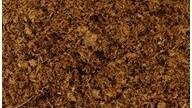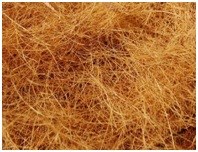Coir as a Component of Growing Media


What is Coir Pith?
Coir is the term given to a range of natural products manufactured from the Cocos nucifera mesocarp or coconut husks. The main horticultural products marketed are coir fiber, coir pith and coir chips/chunks.
Pronounced “coyer” (kȯi(-ə)r), coir pith is the main constituent of most coir products and is commonly used as a component of horticultural growing media. Coir is a renewable resource and a natural by-product of the brown fiber industry of tropical countries such as India, Indonesia, the Philippines and Sri Lanka. Coconut husks are typically soaked in salt water to extract the fibers for many different industries. Coir pith is a by-product of this process and had limited use for horticulture, due to the high salt level. More recently, producers have developed processes to reduce high soluble salts for horticulture applications.
There are three types of coir produced:

|

|

|
Coir fiber is stringy and often used to make hanging basket liners, brooms, mats, etc. and has limited applications in growing media. Coir pith is short-fibered, resembling coffee grounds, and is used in combination with sphagnum peat moss for growing media applications.
Typically, the best quality coir pith is a blend of short fibers and spongy material that are left behind after the long fibers are extracted from the outer coconut husk. More recently, coir chips/chunks have been introduced and are used to provide structure to improve the air porosity of the growing medium. To produce chips/chunks, the coconut husk is cut into specific size pieces. For example, ‘Chunk Coir’ is a key component of PRO-MIX® HPCC AGTIV™ REACH™.
Features and Benefits of Coir
The porous granular structure of coir makes an excellent growing media component and a very good partner with Canadian sphagnum peat moss. Coir has a significant amount of pores for every particle. This physical feature provides more pore space and a better water-holding capacity in the root zone when fully hydrated, generally resulting in increased rooting and germination. Coir pith has been shown to hold up to nine times its weight in water. Grower trials have shown improved rooting in peat/coir-based mixes.
Other properties that make coir a suitable ingredient for blending with sphagnum peat moss for horticultural growing media include:
Keep in mind that coir products will vary, depending on their origin and how they are processed. Using coir may require some adjustments in crop product management practices. These include, but are not limited to, adjustments to watering practices and fertilizer application rates. If you purchase coir to make your own growing media, you will also need to watch for high sodium levels and potential nutritional imbalances from higher potassium levels.
- Coir has a moderate pH – close to 6.0.
- Excellent wetting and re-wetting ability (coir has no waxy cutin to repel water).
- Excellent air and water holding ability at container capacity.
- When blended at 20-30%, coir can reduce media shrinking from the container walls upon drying, so water does not channel down the sides when dry media is irrigated.
- Coir has a high lignin-to-cellulose ratio. Therefore, coir is highly resistant to physical breakdown when handled in flat filling and potting machines, exhibits significantly less shrinkage in growing containers over the life of the crop and maintains a favorable air-to-water balance in the root zone for a long period.
- Coconut husks can be cut into specific sizes for uniform particles.
